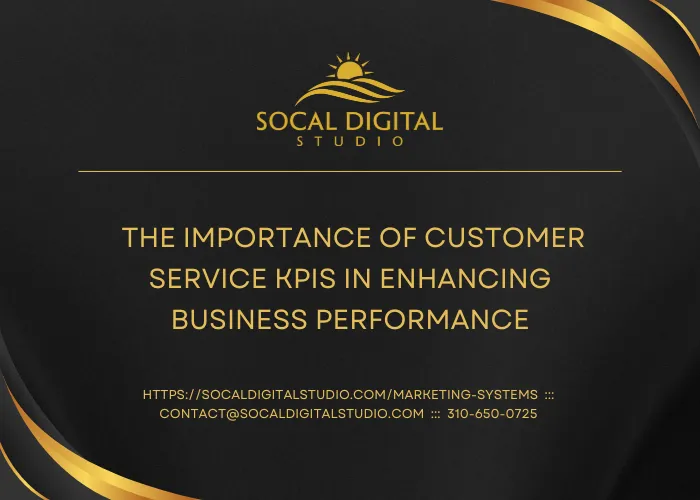PROPELLING SUCCESSFUL BUSINESSES
Actionable Best Practices

The Importance of Customer Service KPIs in Enhancing Business Performance
“There is a spiritual aspect to our lives — when we give, we receive — when a business does something good for somebody, that somebody feels good about them!" - Ben Cohen, Ben & Jerry's Co-Founder
Introduction
In the fast-paced and competitive world of business, the importance of customer service cannot be overstated. Customer service not only defines the quality of your product and services but also reflects the values and priorities of your company. Key Performance Indicators (KPIs) in customer service are essential metrics used to measure the effectiveness, efficiency, and satisfaction levels associated with your business’s customer service efforts. These indicators provide actionable insights that can lead to improved customer satisfaction, loyalty, and profitability. This blog post explores why customer service KPIs are crucial for any business and provides examples to illustrate their importance.

Improving Customer Satisfaction
Customer satisfaction is paramount, as it directly influences repeat business and word-of-mouth recommendations. By measuring KPIs such as the Customer Satisfaction Score (CSAT), businesses can gauge how happy customers are with their services and products. For example, a high CSAT score indicates good customer approval, which typically correlates with higher customer retention rates.
Enhancing Service Efficiency
Efficiency in handling customer inquiries and problems ensures that customers feel valued and respected. KPIs such as Average Handling Time (AHT) and First Response Time (FRT) are critical here. These metrics help businesses monitor how quickly and efficiently customer service teams are responding to and resolving issues. For instance, a shorter FRT can significantly increase customer satisfaction as it reduces customer effort and frustration.
Reducing Customer Churn
Customer churn, the rate at which customers stop doing business with a company, is a vital health metric for any business. Monitoring KPIs like the Customer Churn Rate helps companies identify why customers are leaving and what steps can be taken to retain them. A sudden spike in churn rate might prompt a business to re-evaluate its customer service policies or product quality.
Increasing Profitability
Effective customer service KPIs such as Net Promoter Score (NPS) not only measure customer loyalty but also correlate with a company’s financial performance. Businesses with high NPS scores usually experience more organic growth and better profitability through repeat business and referrals. Measuring and improving these scores can lead to significant financial gains.
Key Customer Service KPIs and Their Impact
1. Net Promoter Score (NPS)
Impact: Determines customer perception and loyalty. A high NPS is often a predictor of growth; it indicates that customers are not only satisfied but are also enthusiastic enough about your service to recommend it to others.
Example: Apple Inc. consistently scores high on the NPS scale, which supports its strong market growth and robust customer loyalty.
2. First Response Time (FRT)
Impact: A fast response can improve customer satisfaction and reduce churn by addressing customer concerns quickly.
Example: Zappos, a leader in online shoe and clothing retail, excels in customer service by aiming for incredibly fast response times, often replying to customers within an hour.
3. Customer Effort Score (CES)
Impact: Measures the ease of customer interaction and resolution of their issues with the company. Lower effort scores mean higher satisfaction and loyalty.
Example: Amazon has streamlined customer interactions by introducing features like one-click ordering, which significantly lowers the CES and enhances customer experiences.
4. Customer Churn Rate
Impact: Helps identify the rate at which customers are leaving your company, which can signal the need for product or service improvements.
Example: Netflix monitors churn closely, using data to understand viewing preferences and customer satisfaction which helps them in content curation and recommendations.
Implementing and Monitoring KPIs
Set Clear Benchmarks
Businesses should establish clear performance benchmarks based on industry standards or past company performance. This strategy allows companies to set realistic and achievable goals for improvement.
Use the Right Tools
Leveraging the right technology and tools is crucial for accurately measuring these KPIs. CRM systems, customer feedback tools, and analytics platforms are essential for gathering data and generating insightful reports.
Regular Review and Adaptation
KPIs should be reviewed regularly to adapt strategies as necessary. This dynamic approach helps businesses stay aligned with customer expectations and market changes.
Conclusion
In conclusion, customer service KPIs are not just numbers to track; they are essential indicators that can help steer a company towards greater efficiency, profitability, and customer loyalty. By effectively measuring, analyzing, and acting on these KPIs, businesses can enhance their customer service, mitigate issues before they escalate, and improve overall customer satisfaction. Remember, the goal is to create a responsive, customer-focused business environment that promotes long-term success and growth. Effective implementation of customer service KPIs is a critical step in achieving this goal.
Customer service is a critical area for small businesses, as it often differentiates them from larger competitors and can be the key to building long-term customer relationships. Effective measurement and management through Key Performance Indicators (KPIs) are essential for enhancing service quality and customer satisfaction. Below is a comprehensive list of customer service KPIs specifically designed for small businesses:
1. Customer Satisfaction Metrics
1. Customer Satisfaction Score (CSAT):
Definition: Measures customer satisfaction with a service, product, or specific interaction. Typically obtained through a survey that asks customers to rate their satisfaction on a scale.
Calculation: Average of all customer satisfaction scores.
2. Net Promoter Score (NPS):
Definition: Assesses customer loyalty and the likelihood of customers recommending the company to others.
Calculation: (Percentage of Promoters - Percentage of Detractors) x 100. Promoters (score 9-10), Passives (score 7-8), and Detractors (score 0-6).
3. Customer Effort Score (CES):
Definition: Measures the ease of customer interaction and resolution of their issues.
Calculation: Average score from customer responses on the ease of handling their request (typically on a scale from "Very Easy" to "Very Difficult").
2. Quality of Service Indicators
1. First Response Time (FRT):
Definition: Tracks the average time taken for a customer to receive the first response to their query.
Calculation: Total time taken to respond for the first time / Total number of cases.
2. Average Resolution Time:
Definition: Measures the average time taken to resolve customer issues from the moment they are reported.
Calculation: Total time taken to resolve issues / Total number of resolved issues.
3. First Contact Resolution (FCR):
Definition: Percentage of customer inquiries or complaints resolved upon first contact with a service representative.
Calculation: (Number of Issues Resolved on First Contact / Total Number of Issues) x 100
4. Call Abandonment Rate:
Definition: Percentage of inbound phone calls made to a service desk that are abandoned by the customer before speaking to a representative.
Calculation: (Number of Abandoned Calls / Total Number of Calls) x 100
5. Quality Assurance Score:
Definition: Reflects the overall quality of interactions as assessed through various quality monitoring tools and methodologies.
Calculation: Based on detailed internal review systems and external audits.
3. Operational Performance Metrics
1. Average Handle Time (AHT):
Definition: The average duration of a single customer interaction, including talk time, hold time, and follow-up tasks.
Calculation: (Total Talk Time + Total Hold Time + Follow-Up Time) / Total Number of Calls
2. Service Level (SL):
Definition: The percentage of calls answered within a predetermined threshold of seconds.
Calculation: (Number of Calls Answered Within Threshold / Total Number of Calls) x 100
3. Occupancy Rate:
Definition: Measures the percentage of time that agents spend handling customer interactions compared to their total logged-in time.
Calculation: (Total Handle Time / Total Logged Time) x 100
4. Ticket Volume Trends:
Definition: Analysis of the number of customer support tickets created over time, which helps in predicting busy periods and scheduling staff
Calculation: Count of tickets per day/week/month.
4. Customer Interaction KPIs
1. Customer Retention Rate:
Definition: The percentage of customers who continue to buy from the small business over a given period.
Calculation: ((Number of Customers at End of Period - Number of New Customers during Period) / Number of Customers at Start of Period) x 100
2. Customer Churn Rate:
Definition: The percentage of customers who stop doing business with the company during a given period.
Calculation: (Number of Customers Lost During Period / Number of Customers at Start of Period) x 100
3. Customer Engagement Level:
Definition: Measures the depth of the customer's engagement with the company's support channels (e.g., frequency of interactions).
Calculation: Varies based on channels used and interaction types (e.g., number of customer-initiated interactions per month).
4. Upsell/Cross-sell Rate:
Definition: The success rate of attempts to sell additional or complementary products to existing customers.
Calculation: `(Number of Successful Upsell/Cross-Sell / Total Number of Opportunities) x 100`
5. Feedback and Continuous Improvement
1. Post-Interaction Surveys:
Definition: Surveys conducted after customer interactions to gather feedback on customer satisfaction and areas needing improvement.
Calculation: Compilation of feedback scores and qualitative feedback.
2. Complaint Resolution Rate:
Definition: Measures how effectively customer complaints are resolved.
Calculation: (Number of Complaints Resolved / Total Number of Complaints) x 10
Implementation and Monitoring
For small businesses, implementing these KPIs involves setting clear performance targets, regularly tracking these indicators, and using the insights gained to improve service continuously. Tools such as CRM software, customer support platforms, and even simple spreadsheets can be invaluable in this effort. By consistently measuring and analyzing these KPIs, small businesses can achieve higher customer satisfaction, improved operational efficiency, and ultimately, sustained business growth.
Let Us Help Set Up Your Customer Service KPI Dashboard
To design and manage a customer service system tailored to your business, partnering with a knowledgeable consultant and implementing a marketing system can be highly beneficial. Remember, in the world of business, effective marketing is not just money—it's customer satisfaction, retention, and your brand’s reputation on the line. Schedule a free demo with us by CLICKING HERE to discover cutting-edge ways to place your marketing resources in the most effective activities.

SUBSCRIBE TO THIS NEWSLETTER TO STAY IN THE KNOW
Please contact us with topics you would like us to cover
Dominate with Our Affordable All-in-One Marketing System
SoCal Digital Studio's Advanced All-In-One Marketing System is built to help local businesses attract, engage, convert, and retain customers with speed and consistency. It automates the communication that is essential to a business' success and continuing growth. Request a free marketing audit to uncover weaknesses and use SoCal Digital Studio's Marketing System to not only compete, but dominate the market.
All-in-One Marketing System
Leverage Powerful Marketing Tools and Sales Funnels to Nurture and Convert Customers at an Affordable Price
Our marketing system has it all and allows you to (1) capture leads via landing pages, forms, calendars, and inbound phone calls; (2) message leads via phone calls, SMS, emails, and Messenger; and (3) close leads with built-in tools for payments and analytics (including call tracking).You can also create landing pages and funnels, set up automated follow-up campaigns, schedule appointments, fine-tune marketing and sales processes, and manage all of it so nothing slips between the cracks in your dedicated marketing system.
Stellar Package
Monthly Subscription
12-Month Subscription is $4970
One-Time Set-Up Fee Varies
$297
Full System Access
5,000 Contacts
1,500 SMS or Calls
15,000 Emails
1-3 Team Members
Galactic Package
Monthly Subscription
12-Month Subscription is $6970
One-Time Set-Up Fee Varies
$497
Full System Access
7,500 Contacts
3,000 SMS or Calls
30,000 Emails
4-10 Team Members
Cosmic Package
Monthly Subscription
12-Month Subscription Is $9970
One-Time Set-Up Fee Varies
$697
Full System Access
10,000 Contacts
4,500 SMS or Calls
45,000 Emails
11-15 Team Members
